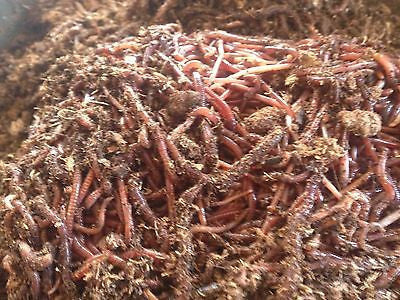Examine This Report on Red Wiggler Express
Red Wiggler Express Things To Know Before You Buy
Table of ContentsThe Definitive Guide for Red Wiggler ExpressFacts About Red Wiggler Express RevealedUnknown Facts About Red Wiggler ExpressRed Wiggler Express Things To Know Before You BuyThe Main Principles Of Red Wiggler Express The Facts About Red Wiggler Express Revealed
Red wigglers and garden compost worms' favorite foods are most fruits - they specifically love bananas, strawberries, raspberries, blueberries, peaches, and melons! Yes - yet we advise feeding potato peels to worms in moderation (Red Wigglers For Bait). Potato peels are starchy and do not damage down quickly so they can take a while for the red wigglers to breakdown and take inWe feed our worms at Brothers Worm Ranch two times a week, and a lot of us do the same with our worm bins in the house. Red wigglers have a tendency to consume even more when temperatures are moderate (60-80 degrees), so you might find a requirement to feed them much more during these periods. If you are leaving for getaway or a trip and are stressed concerning your worms, there are a couple of points you can do to ensure their survival.
Just follow these actions and your wiggly pals should be fine while you're gone: Mix in fresh bed linens to the container. Bed linen can be the original sort of bedding you used or several handfuls of shredded cardboard. Give the surface area of the bed linen a heavy misting so the bed linens does not dry.
The Ultimate Guide To Red Wiggler Express
Place an item of cardboard over the surface area of the bin (this will certainly help it keep moisture). If you are leaving for greater than 2 weeks, we recommend having a pal or member of the family feed and water the worms every 1.5 weeks while you are gone. You can leave food for the worms in the fridge and a tiny spray container for watering.
Thanks for reading and satisfied farming!.
Red worms are nature's best composting worm and a wonderful pick for worm farms. Red worms pass several names. They're usually called red wigglers, tiger worms, manure worms, composting worms, and the trout worms. Whatever you call them they're among the finest composting worms available. Both initial time and skilled worm farmers select the red worm for lots of factors.
Get This Report on Red Wiggler Express


Red worms have several homes which make them excellent for the compost container. Of all the worms appropriate for worm farming the red worm is the most adaptable and passionate.
Decomposing leaves, grasses, timber, and animal manure are all favorites of red worms. The red worm's voracious hunger makes it the champion of the garden compost bin and a digital worm spreading (a.k.a. worm poop) makers. Red worms are relatively little, typically getting no larger than 5 inches. However don't undervalue them.
A 24" x 24" worm bin can conveniently house over 1000 red worms. For those interested in elevating bait worms it's good to keep in mind that jampacked red worms will certainly remain fairly skinny and brief.
Some Known Incorrect Statements About Red Wiggler Express
An additional benefit of red worms is their capability with stand a vast array of temperature level extremes. Typically red wigglers thrive in temperature levels between 65F and 80F (18 C 27 C). When the temperature level dips red worms need to be secured from freezing weather condition. Even red worms kept outside can easily survive the cold temperature levels of north North America. Worm Farms United States.
; when temperatures surge maintain your worm farm cool. If your bed linens gets over 85 levels red worms will try to leave your bins for cooler locations.
If you don't feed them they will certainly go seeking food. Like all worms red worms breathe oxygen with their skin. In order to breathe they call for a moist, but not saturated bed linens material. A damp environment also facilitates the failure of raw material in their bed linens material by microbial life types.
A worm ranch packed with red wigglers is a superb way to compost food scraps, left overs, garden waste, and leaves. Feeding redworms is quite very easy, but there are some fundamental however important things to bear in mind in order to keep you worm ranch healthy and balanced. In this area we will cover what you ought to and must not be feeding your worms.
Red Wiggler Express Fundamentals Explained

However prior to dropping off all the needed reproductive products are scooped up right into the ring. When the mucus ring hands over the worm completion seals up, causing it to taper at one end, triggering the acquainted lemon form of the cocoon. Over the following 20 days the cocoon dims and sets.
Like all worms red worms take a breath oxygen with their skin. A damp atmosphere likewise assists in the breakdown of organic issue in their bedding product by microbial life kinds.
A worm ranch filled with red wigglers is an outstanding way to compost food scraps, left overs, yard waste, and leaves. Feeding redworms is rather very easy, yet there are some standard however crucial points to bear in mind in order to keep you worm farm healthy. In this area we will certainly cover what you need to and should not be feeding your worms.
Indicators on Red Wiggler Express You Need To Know
Throughout mating worms slide along each other till their clitellum are aligned. Throughout the breeding session, which lasts for about 3 hours, the worms produce mucus rings around themselves.
